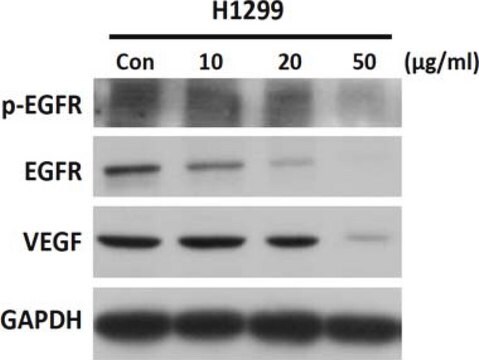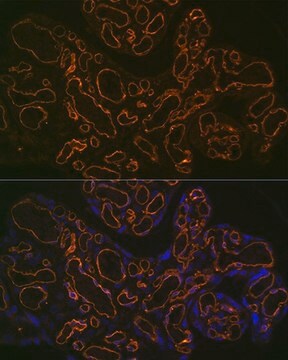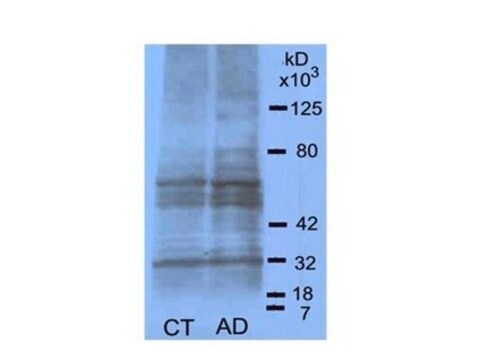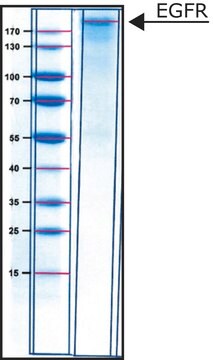R5278
Anti-RAGE (Receptor for Advanced Glycation Endproducts) antibody produced in rabbit
affinity isolated antibody
Sign Into View Organizational & Contract Pricing
All Photos(1)
About This Item
Recommended Products
biological source
rabbit
Quality Level
conjugate
unconjugated
antibody form
affinity isolated antibody
antibody product type
primary antibodies
clone
polyclonal
species reactivity
mouse, rat
technique(s)
immunohistochemistry: 1-2 μg/mL using transgenic mouse retina
western blot: 1 μg/mL using using mouse lung extract
UniProt accession no.
shipped in
dry ice
storage temp.
−20°C
target post-translational modification
unmodified
Gene Information
human ... AGER(177)
mouse ... Ager(11596)
rat ... Ager(81722)
General description
Receptor for advanced glycation end products (RAGE), also known as advanced glycosylation end-product specific receptor (AGER) is encoded by the gene mapped to human chromosome 6p21. The encoded protein is a member of the immunoglobulin superfamily of cell surface molecules.
Immunogen
synthetic peptide corresponding to amino acid residues 362-380 from rat RAGE. This sequence is 100% conserved in mouse and 70% conserved in human.
Application
Anti-RAGE (Receptor for Advanced Glycation Endproducts) antibody produced in rabbit has been used in western blot and flow cytometry.
Applications in which this antibody has been used successfully, and the associated peer-reviewed papers, are given below.
Western Blotting (1 paper)
Western Blotting (1 paper)
Biochem/physiol Actions
The soluble form of receptor for advanced glycation end products (RAGE) has a function in the Wnt pathway. RAGE has a role in the development of inflammatory and cellular damage, as well as cellular toxicity. It has been associated with diabetic atherosclerosis. AGER/RAGE also modulates cell proliferation, differentiation and apoptosis.{93
Physical form
Solution in phosphate buffered saline containing 1.0 mg/mL bovine serum albumin and 0.05% sodium azide.
Disclaimer
Unless otherwise stated in our catalog or other company documentation accompanying the product(s), our products are intended for research use only and are not to be used for any other purpose, which includes but is not limited to, unauthorized commercial uses, in vitro diagnostic uses, ex vivo or in vivo therapeutic uses or any type of consumption or application to humans or animals.
Not finding the right product?
Try our Product Selector Tool.
Storage Class Code
10 - Combustible liquids
WGK
nwg
Flash Point(F)
Not applicable
Flash Point(C)
Not applicable
Choose from one of the most recent versions:
Already Own This Product?
Find documentation for the products that you have recently purchased in the Document Library.
Susmita Barman et al.
Chemico-biological interactions, 307, 37-50 (2019-04-23)
Zinc depletion during diabetes postulates a role for zinc nutrition in the management of associated complications. The present study evaluated zinc supplementation for countering the compromised intestinal integrity through moderation of oxidative stress and suppression of stress-stimulated inflammatory proliferation in
Pradeep, S. R., & Srinivasan, K. (2018). Alleviation of oxidative stress-mediated nephropathy by dietary fenugreek (Trigonella foenum-graecum) seeds and onion (Allium cepa) in streptozotocin-induced diabetic rats.
Pradeep S R and Srinivasan K
Food & Function (2018)
Genome-wide association studies of asthma.
Tamari M, et al.
Allergology International, 60(3), 247-252 (2011)
An inverse association between serum soluble receptor of advanced glycation end products and hyperandrogenism and potential implication in polycystic ovary syndrome patients.
Liao Y, et al.
Reproductive Biology and Endocrinology, 15(1), 9-9 (2017)
Association of RAGE gene Gly82Ser polymorphism with coronary artery disease and ischemic stroke
Ma W Q, et al.
Medicine, 95(49) (2016)
Our team of scientists has experience in all areas of research including Life Science, Material Science, Chemical Synthesis, Chromatography, Analytical and many others.
Contact Technical Service








